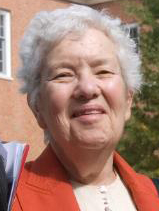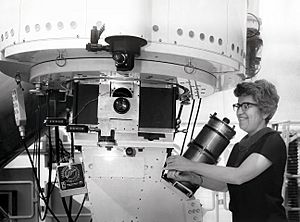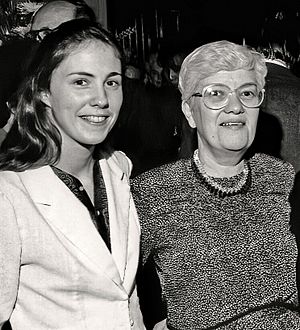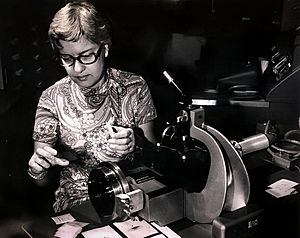Vera Rubin facts for kids
Quick facts for kids
Vera Rubin
|
|
|---|---|

Rubin in 2009
|
|
| Born |
Vera Cooper
July 23, 1928 Philadelphia, Pennsylvania, U.S.
|
| Died | December 25, 2016 (aged 88) Princeton, New Jersey, U.S.
|
| Alma mater | |
| Known for |
|
| Awards |
|
| Scientific career | |
| Fields | Astronomy |
| Institutions | |
| Thesis | Fluctuations in the Space Distribution of the Galaxies (1954) |
| Doctoral advisor | George Gamow |
| Other academic advisors |
|
| Notable students |
|
Vera Florence Cooper Rubin (July 23, 1928 – December 25, 2016) was an American astronomer. She made a huge discovery about how galaxys move. She found that galaxies spin much faster than they should, based on the stars we can see. This led her to suggest that something invisible, called dark matter, must be holding them together. Her work gave strong proof that dark matter exists.
Vera Rubin started her studies at Vassar College. She was the only astronomy student there. Later, she went to Cornell University and Georgetown University. During her studies, she noticed that galaxies were not just moving away from each other, but also grouping together. She received many awards for her important work, including the Gold Medal of the Royal Astronomical Society.
Rubin also worked hard to support women in science. She helped many young female astronomers. In 2015, a new observatory, the Vera C. Rubin Observatory, began construction. It was named after her. Her discoveries changed how we think about the universe.
Contents
Early Life and First Discoveries
Vera Cooper was born in Philadelphia, Pennsylvania, on July 23, 1928. Her parents were immigrants from Eastern Europe. Her father, Philip Cooper, was an electrical engineer. Her mother, Rose Applebaum, worked at the same company.
When Vera was 10, her family moved to Washington, D.C. She became very interested in the stars. She once said, "Even then I was more interested in the question than in the answer." She and her father built a simple telescope from cardboard. With it, she watched and tracked meteors. She graduated from high school in 1944.
Vera Rubin's Education
Vera wanted to study astronomy at Vassar College. This was an all-women's school at the time. She was inspired by Maria Mitchell, a famous astronomer who taught there. A high school teacher told her not to study science, but she didn't listen. She graduated in 1948 with a degree in astronomy. She was the only one in her class to do so.
After Vassar, she tried to join a graduate program at Princeton University. But Princeton did not accept women into their astronomy program for another 27 years. She also turned down an offer from Harvard University.
In 1948, she married Robert Joshua Rubin. He was also a student at Cornell University. Vera then enrolled at Cornell and earned her master's degree in 1951. There, she studied how 109 galaxies moved. She was one of the first to notice that galaxies were not just spreading out, but also moving in groups. This idea was very new and caused a lot of debate.
Vera continued her studies at Georgetown University. It was the only university in Washington, D.C., that offered a graduate degree in astronomy. She was 23 and pregnant when she started her Ph.D. Her advisor was George Gamow. In 1954, she finished her Ph.D. Her research showed that galaxies tend to clump together, not spread randomly. This idea was also very controversial at the time. She faced challenges because she was a woman. For example, she was not allowed in her advisor's office because women were not permitted in that part of the university.
Her Career and Big Discoveries
After her studies, Vera Rubin worked at different places. From 1955 to 1965, she was at Georgetown University. In 1965, she joined the Carnegie Institution of Washington. There, she met Kent Ford, who became her long-time partner in research. She did much of her work from home because she had young children.
In 1963, Rubin started looking at how galaxies rotate. She used a large telescope at the McDonald Observatory. In 1965, she wanted to observe at the Palomar Observatory. There were no restrooms for women there. So, she made her own women's restroom. She became the first female astronomer to observe at Palomar.

At the Carnegie Institution, Rubin and Ford used a special tool called an image-tube spectrograph. This tool helped them see the light from very dim objects in space. They studied spiral galaxies, like the Andromeda Galaxy. They found something strange: the outer parts of galaxies were spinning just as fast as the inner parts. This was unexpected. If only the visible stars were creating gravity, the outer parts should spin slower. This suggested that a lot of unseen mass was present. This unseen mass is what we now call dark matter.
Rubin's calculations showed that galaxies must have five to ten times more dark matter than ordinary matter. Her findings were confirmed by other scientists over the years. They became the first strong proof for the idea of dark matter. This idea was first suggested by Fritz Zwicky in the 1930s.
Rubin also discovered that some gas and stars in galaxies moved in the opposite direction to the rest of the galaxy. This was a big surprise! It showed that galaxies could merge and that they formed in complex ways.
In 2000, Vera Rubin wrote a review called "One Hundred Years of Rotating Galaxies." This was based on a lecture she gave in 1996. She received the Gold Medal of the Royal Astronomical Society that year. She was only the second woman to get this award, 168 years after Caroline Herschel. In 2002, Discover magazine named Rubin one of the 50 most important women in science. She continued her research until she passed away in 2016.
Vera Rubin's Legacy
Vera Rubin was elected to the National Academy of Sciences. She was only the second woman astronomer to join this group. Many scientists believe she should have won the Nobel Prize for her work. She was seen as a "guiding light" for women who wanted to have both a family and a career in astronomy.
Rubin passed away on December 25, 2016. The president of the Carnegie Institution called her a "national treasure." The Carnegie Institute created a research fund in her honor. The American Astronomical Society also named a prize after her, the Vera Rubin Early Career Prize.
Vera Rubin has been honored in many ways. She was featured in the TV show Cosmos: A Spacetime Odyssey. A place on Mars, Vera Rubin Ridge, is named after her. An Asteroid, 5726 Rubin, also carries her name. In 2020, a satellite called "Vera" was launched into space.
Vera C. Rubin Observatory
On December 20, 2019, the Large Synoptic Survey Telescope was renamed the National Science Foundation Vera C. Rubin Observatory. This was to honor her work on dark matter and her efforts to support women in science. This observatory is being built on a mountain in Chile. It will focus on studying dark matter and dark energy.
In Media
The Verubin Nebula in Star Trek: Discovery is named after Vera Rubin. A children's book about her, The Stuff Between the Stars: How Vera Rubin Discovered Most of the Universe, was written by Sandra Nickel.
Awards and Honors
Vera Rubin received many important awards and honors:
- Member of the National Academy of Sciences (1981)
- Member of the Pontifical Academy of Sciences
- Gold Medal of the Royal Astronomical Society (1996)
- National Medal of Science (1993)
- Honorary degrees from top universities like Harvard University and Princeton University
Personal Life

Vera Rubin was married to Robert Joshua Rubin from 1948 until he passed away in 2008. She raised four children while doing her important research. All four of her children earned PhDs in science or math. Her children later said that their mother made science seem exciting and fun. This inspired them to become scientists too.
Vera Rubin faced challenges as a woman in science. This made her want to help other girls and women. She encouraged them to follow their dreams in astronomy. She worked with others to get more women recognized in science. She was often sad that not enough women were chosen for important science groups.
Vera Rubin was Jewish. She believed that science and religion could exist together. She said, "In my own life, my science and my religion are separate. I'm Jewish, and so religion to me is a kind of moral code and a kind of history. I try to do my science in a moral way, and, I believe that, ideally, science should be looked upon as something that helps us understand our role in the universe."
Images for kids
See also
 In Spanish: Vera Rubin para niños
In Spanish: Vera Rubin para niños



